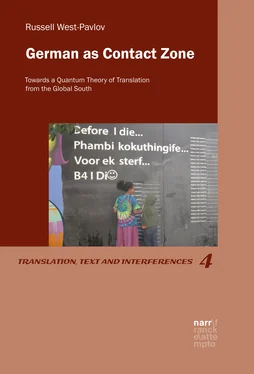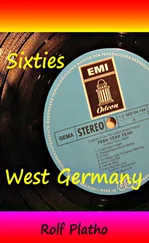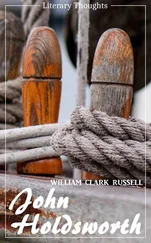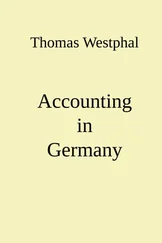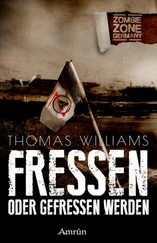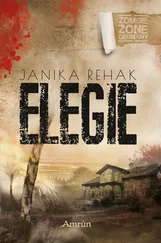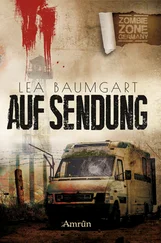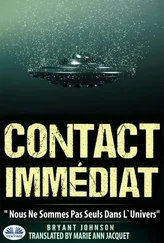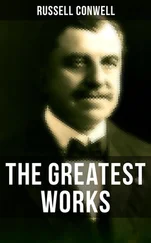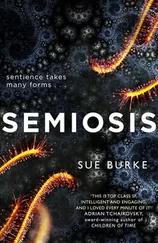1 ...6 7 8 10 11 12 ...26 Chapter 13 views the translation classroom from another point of view, asking about its integration into the field of contemporary German political debates in a rapidly changing world. It opens with the notion of the blackboard as a fourth wall that often separates the classroom from the world outside. It begins by interrogating contemporary racism as it spikes in response to the global multi-crises of the present time (Brand and Wissen 2017: 21-42), and enquiring how racism can be combated in the classroom. Racism is analysed as a local epiphenomenon of other segregative, separative dynamics in the world. Against this broader background of rampant, almost-universal separatism, the chapter proposes a translative methodology for the classroom, one that seeks to create connections between disparate domains of knowledge so as to map the contemporary global landscape. Translation, as a universal creative and connective process, can be put to work in the classroom in a way that unleashes larger dynamics of epistemological and political creativity via what Pratt calls ‘the pedagogical arts of the contact zone’. (An appendix to the volume explores cognate issues in the German EFL classroom.)
The conclusion takes up chapter 13’s notion of the blackboard as the ‘fourth wall’ of the translation, looking at a very real, if ephemeral blackboard-wall that could be found as a street-art intervention for a short period in inner-city Johannesburg. That blackboard addresses its audiences in a number of languages—English, Zulu, Afrikaans, and ‘textese’—to ask what they dream of doing in the time ‘before they die’. Each addressee is invited, in the language of her or his choice, to fill in the blank line (‘Before I die_______’) just as they must, willy-nilly, fill the interval of the remaining days of their life. The blank or empty space invites readerly participation in the form of writing. The space between the wall and the street, between the words and the world, becomes a spatio-temporal and linguistic-existential ‘contact zone’. Participation generates transformation between the poles of concretely embodied language and language-borne humans. Writing the blank space of an ongoing and future life happens within the tensile fabric of a life-being-lived between various actants. The street in Johannesburg thus becomes a South-South translation—doubtless a very circuitous one—of the Chinese cosmologies expounded by François Jullien in his work on seventeenth-century neoconfucianism (1989, 2016). Those cosmologies posit that between paired opposites—night and day, light and dark, mountain and water, emptiness and fullness—a constant flow of energy, a translative exchange of information, takes place in such a way as to disqualify these pairs as polarized binaries because their relationship is one of dynamic transformation. The difference that pertains between them is the difference between the phases of a ceaseless process of transformation (Jullien 1989)—the pulse of life itself, its undulating expanse. Life ‘adheres’ to itself in its persistence by ‘disadhering’ to itself in its energetic push through the stages of a restless self-transformation (Jullien 2016: 17-39). Even the description, the writing that package this presentation—indeed, the translative (and transliterative!) work, both cultural and linguistic, that precedes it, within a genealogy running from Wang Fuzhi to Tan Sitong to Mao Zedong to François Jullien (Jullien 1989: 14)—are instances of the immense, vibrant ‘contact zone’ that is life as cosmic translation. Join in by reading on, never forgetting that you will be translating all the way.
PART 1: Translation in theory
Chapter 1: Turning Translation
From the 1980s onwards, translators finally got their long-awaited turn to have a ‘turn’ (Robinson 1991; Snell-Hornby 2006), emerging from the marginality of a secondary, derivative and often elided practice to the fully-fledged status of a cultural practice and an academic discipline (Venuti 1998). After the famous ‘linguistic turn’ that inaugurated structuralism and poststructuralism, a number of other ‘sub-turns’ followed, among them the ‘translational turn’ (Bachmann-Medick 2007: 238-81). This ‘turn’ was in reality already a double affair: the cultural turn in translation studies, which had hitherto been a largely technical and instrumentalist discipline, was followed by a translative turn in cultural studies. Translation studies were released from a restricted text-linguistic base centred on questions of original and derivative status, measures of ‘fidelity’, to explore the manifold cultural processes of cross-border communication, cross-cultural negotiation and so on in a much broader sense. Subsequently translation studies emerged as a cultural paradigm in their own right. These incremental shifts away from a narrow notion of translation as an exclusively linguistic process of semantic transfer between natural or even national languages did not, however, go unresisted. Rather, such successive border infringements were registered with increasing disapproval by putative guardians of disciplinary purity. In this opening chapter I wish to use that moment of resistance as a heuristic device to interrogate the very notion of a translational border and point to possible ways of overcoming it in an even more radical manner.
From translation in culture to culture as translation
What took centre stage in the new version of culturalist translation studies or translational (above all postcolonial: Bassnett and Trivedi, eds 1999; Niranjana 1992) cultural studies was a version of translation drawn from anthropology. That vision of translation as a mode of anthropological hermeneutics imagined how local cultural practices need to be ‘translated’ by the outside interpreter within a whole context of meaning, generating a method that Appiah, building of course upon Geertz’s (1993: 3-30) ‘thick description’, calls ‘thick translation’ (Appiah 1993).
With a slight shift of cultural and disciplinary context, colonial and postcolonial histories came to be seen as long processes—going far back of course into precolonial histories—of cross-cultural translation that were always already imbued with unequal power relations and hierarchies of access to voice, representation and the technology of transmission: what Pratt (1991: 37), already quoted above, has called ‘the literate arts of the contact zone’: ‘Autoethnography, transculturation, critique, collaboration, bilingualism, mediation, parody, denunciation, imaginary dialogue, vernacular expression’. From translation as a cultural practice, whose meaning spread metonymically from its ‘origin’ in standard interlingual translation as part of the process of imperial conquest (Mufti 2016: 103-7) or the more localized and embedded practices of agents such as native interpreters, the concept then congealed, via a chiastic inversion, into a metaphor, that of culture as translation (e.g. Budick and Iser, eds, 1996). This slide from translational metonymy to translation as metaphor might be seen as an example of ‘concept drift’ (Tsymbal 2004).
The complexities of such ‘drift’ could however be exemplified by the protagonist of Amadou Hampaté Bâ’s L’étrange destin de Wangrin (1992), an interpreter in colonial French West Africa (Bâ himself was born in Mali, worked in Senegal and died in Côte d’Ivoire) who exploits his median position between colonizer and colonized, between North and South, to plunder the rich and give to the poor. His colonial identity, which emerges out of a crucial activity of translative negotiation between colonizers and colonized, is intertwined with a residual trickster role drawn from Fula oral narrative traditions, where the ambiguity of translation and betrayal, traduction et trahison , traduttore traditore , is constantly in play. Here culture itself comes to be seen as the translation of traditions from one epoch to another, with the colonial moment as one where the betrayal by the native of her or his own culture is a constant haunting guilt (Bewes 2011) or at the very least a complex knot to be incessantly negotiated. Various types of translation as cultural practice are intertwined here, but they are overshadowed by a sense of culture itself as a precarious translative practice threatened by the disruptive inroads of the colonizing culture. In Bâ’s (1960) own words, ‘En Afrique, quand un vieillard meurt, c’est une bibliothèque qui brûle’ [‘In Africa, when an old man dies, a library is burnt down’]. By the same token however, culture as a translative process can survive this process of erosion if its imminent disappearance is palliated by resistant, restorative forms of translation as a type of ‘counter-memory’ (Foucault 1977). Convesely, translation as a cultural process may itself play a restorative, reparative or compensatory role in such contexts (Bandia 2014; Batchelor 2009).
Читать дальше
